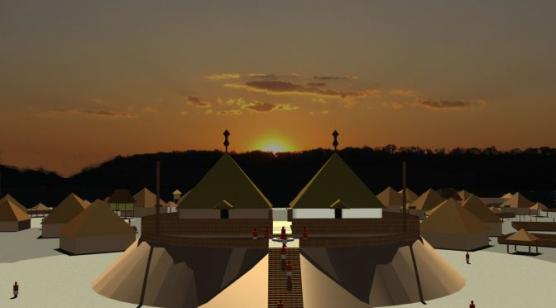Dear Dr. Marrero:
Congratulations on the many outstanding achievements by the University of West Georgia under your leadership. Although not personally an alumnus of West Georgia, it holds a special place in my heart. You will see why.
My mother was the first person in her family to graduate from a public high school. She was in the first generation of Creek Indian youth, who were even allowed by the state of Georgia to attend public schools. At age 16, she was valedictorian of her graduating class and received a full scholarship to West Georgia College. West Georgia then consisted of two academic buildings and two dormitories! It was a two year college.
After she finished West Georgia with straight A’s, my grandfather drove her to Athens, GA in a mule wagon, where she went on to graduate Summa Cum Laude from the University of Georgia.
In her highly successful teaching career that followed, my mother received a masters degree from West Georgia, was twice named Teacher of the Year in Georgia, received a Six Year Education Certificate from West Georgia, trained student teachers and served on the West Georgia Alumni Advisory Board until her death.
Obviously, we Creeks are NOT a stupid, ignorant people as several Georgia archaeologists have recently described us in public. Well . . . a 2012 editorial in the American Institute of Archaeology Journal by an anthropology professor from outside the Southeast, labeled me personally . . . “nothing, but an ignorant peon.” He knew absolutely nothing about my educational or professional background. There is obviously a “serious attitude problem” among Gringo archaeologists.
There is even another connection to your fine institution. Many years ago, immediately after I returned home from completing a fellowship in Mexico, where I studied Mesoamerican architecture and planning, the West Georgia Department of Anthropology invited me to give a lecture there. This was even before I started teaching classes on the subject at Georgia Tech, my alma mater.
To get to the point . . .
The University of West Georgia and Auburn University are located in the last territory held by the Creek Confederacy, before the majority of Muskogee Creeks were forcibly marched to Oklahoma. However, even today there are thousands of Creek descendants in your region. Furthermore, in the past 30 years over a million Latin Americans, most with substantial indigenous ancestry, have moved to Georgia. They are our cousins. The ancestors of the Creeks came from Mexico, Central America, Cuba and northwestern South America. Thus, people of kindred indigenous ancestry now represent a substantial political constituency in Georgia. Do university curricula in Georgia reflect this fact? I think not.
The States of Florida and Alabama, Auburn University in particular, have in recent decades come to appreciate their Muskogean (Creek, Seminole, Chickasaw, etc) heritage and incorporate our rich history into their educational curricula. Meanwhile, Georgia bureaucrats, professors and archaeologists began a quixotic campaign around 1991 to minimize the state’s Creek, Uchee, Chickasaw and Mesoamerican heritage in a ridiculous presumption that it would somehow result in “Cherokee gambling casinos” being permitted by the federal government in Georgia.
My grandparents, uncles and mother would rage each time as the propaganda machine progressively distorted the past in newspaper articles and yes, even official press releases by state agencies. However, they did nothing. You see . . . the way we remaining Creeks in Georgia survived for 180 years was by being invisible. My mother taught her students the truth, but it never dawned on her that she could go public and chew out those cynical bureaucrats and ignoramus professors for distorting Georgia’s history. Those times have changed.
First a little bit of factual history, since you moved here from Florida. In 1540, all the Native American town names mentioned by the chroniclers of the Hernando de Soto Expedition, while the conquistadors were traveling through Georgia, South Carolina, North Carolina and eastern Tennessee were either Creek or Itza Maya words. In 1700, all Native American provinces within the current boundaries of the State of Georgia were ancestral to the Creek Confederacy.
A map published in 1725 was the first to show a couple of small villages in the northeastern tip of Georgia as being Cherokee. However, even as late as 1776, official British Army maps estimated that there were no more than 100 Cherokees in the entire colony of Georgia, which then stretched all the way to the Mississippi River.
Cherokee refugees poured into the new state of Georgia in the 1780s and 1790s, but even at its maximum size, the Cherokee Nation represented only about 20% of the state’s land area. The vast majority of Cherokees were gone from Georgia by 1838. Nevertheless, the US Census in 1830 estimated that over 20,000 Creeks remained in Georgia after the Muskogee Creeks were removed from the state in 1827. Most Creeks living outside the boundaries of the Creek Confederacy in Georgia were from other branches of the Creeks and did not feel bound by a treaty signed by the Muskogees.
In late winter of 2015, I was made aware of a videotaped lecture by an anthropology professor at West Georgia, which was dated February 15, 2015 and proudly published on the web by the Anthropology Department. Entitled “The History of the Cherokees and Creeks in Georgia,” it opened up with the statement, “The Cherokees and Creeks have been living in Georgia for thousands of years” and went downhill from there. Most of the lecture was fiction about the “Pre-European Contact Cherokees in Georgia.” His less fictional version of the Creeks was treated as “also and.”
Oh there were bits of truth mixed into the lecture and he got the English names of our pottery styles correct. However, he labeled several Creek towns in Georgia as being Cherokee. He also gave the Cherokees credit for making arrowheads, producing pottery, plus building towns and mounds in Georgia that occurred many centuries before the Cherokees were anywhere around.
More disturbing to me was the obvious ignorance that this professor had of Georgia’s diverse ethnic heritage. He had a PhD from the University of Georgia, yet had no clue that the peoples, who formed the Creek Confederacy spoke several languages and many dialects. They were not one ethnic group. For example, the people living immediately northeast of the University of West Georgia were originally Arawaks from Cuba. Most of southeast Georgia in 1540 was occupied by peoples from South America.
I didn’t go public at the time, because I was not sure if the transgressions of this particular professor composed an isolated problem. The fact was that he was later rewarded by a faculty position at Western Carolina University, where he has received a grant from the Eastern Band of Cherokees to study “the Cherokee mounds in the Southeast.” There are no such things. The Cherokees never claimed to have built mounds until about 20 years ago.
I asked a relative, attending West Georgia, to enroll in some anthropology and history classes there in order to see what was really going on. The entry level anthropology classes are pretty much the same as the lecture last February, but without the extreme and fictional emphasis on the Cherokees being in Georgia before the 1720s. Nevertheless, the professors do state that the Cherokees always lived in certain traditional Creek areas of Georgia.
She said that some archaeology professors at some Georgia universities claimed to incorporate Native American input in their work. They intentionally avoid communicating with Creeks from Alabama, Georgia and Florida, because we are too well educated. Instead they fly in some marginally educated Creek elder from Oklahoma and let him or her look at an archaeological dig for a few hours, then fly them home. The Oklahoma Muskogee Creeks have been gone from the region for over 180 years. Most of the Georgia Creeks were not even Muskogees. At any rate, the Oklahoma Creeks have forgotten much of their heritage from before the Trail of Tears.
She joked that the funniest thing was that the anthropology and history professors thought she was an extremely tall, second generation Mexican-American with a Southern drawl. They had no clue what a Creek Indian looks like, but presented themselves as experts on the Creeks.
She added that in general, West Georgia professors are careful to be politically correct in their contacts with African-American students. In contrast, because such a high percentage of professors are from other areas of the United States, there is a subtle presumption among them that those students with black hair and olive complexion are foreigners, and thus, products of inferior cultural backgrounds. In other words, my mother would have been treated the same way, even though her Caucasian and Native heritage in Georgia predated the state’s existence.
When Southeastern anthropologists are challenged by Native Americans concerning the accuracy of what they are teaching students, they typically retreat to a position in which they present themselves as an intellectual elite that has exclusive domain over our heritage. Their intellectual superiority over the Creek descendants in Alabama, Florida & Georgia is highly questionable.
In seeking to not appear provincial, they become just that
There is another problem in Southeastern universities, which I have observed, that my third cousin did not mention. It is especially severe at Georgia Tech, Georgia State and the University of Georgia. In order to present themselves as being cosmopolitan and international, these three universities have intentionally hired professors from other regions of the nation and other nations. That is a fine objective, up to a point, but . . .
Of course, I have already explained how the anthropology professors present a simplified, actually fictional, version of Georgia’s Native American history, but the problem goes far beyond that. Many professors employed by the University System of Georgia are contemptuous of anything within the state that pays for their livelihood. I have personally found that geology professors at all three institutions knew virtually nothing about the geology of Georgia. None knew that we had an ancient chain of volcanoes in the state that is the source of our gold and precious stone deposits.
Georgia Tech architecture professors know next to nothing about the prehistoric and historic architecture of Georgia, despite the fact that European architects come to Savannah to study its planning and architecture. When I contacted Tech’s College of Architecture about me coming over to show the students powerpoint slides of the state’s 16th & 17th century colonial architecture, plus much earlier Native American towns, the Dean’s office thought it was a great idea. The out-of-state professors, who the Dean had hired, wouldn’t even communicate with me. Guess they didn’t want to appear provincial.
Native American history is America’s heritage. An accurate understanding of Georgia’s culturally advanced, indigenous peoples is a heritage that all Georgians should know and cherish.
Sincerely Yours,
Richard L. Thornton, Registered Architect and City Planner
Architect of the Trail of Tears Memorial in Tulsa, Oklahoma
CC: Dr. Hank M. Huckaby, Chancellor of the University System of Georgia
















